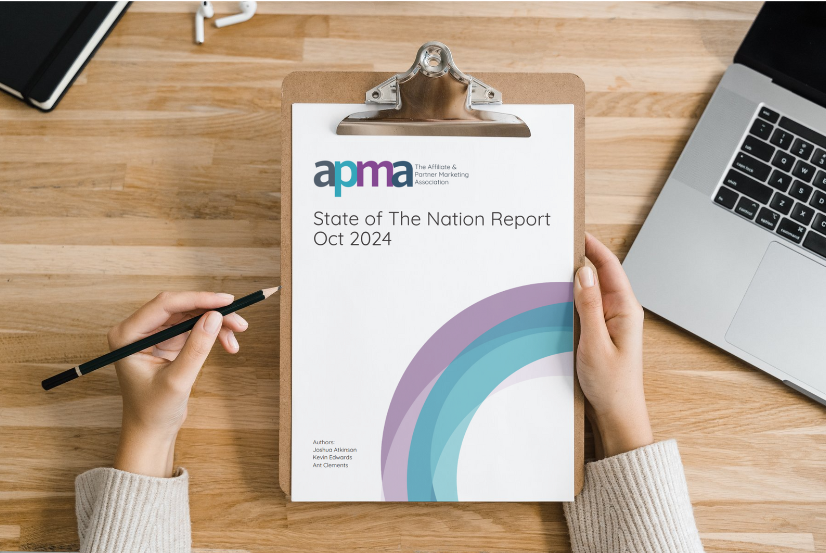
Launching the APMA’s ‘State of the Nation’ is a huge cause for celebration.
In capturing the channel’s size, scale and scope for the first time in a decade, we can definitively salute a true British success story.
At 17% year-on-year growth, affiliate and partner marketing is an e-commerce powerhouse. British brands spent close to £1.7bn in 2023 and, per capita, embrace the channel more the US. In fact, British affiliate marketers likely lead the world in their adoption of it.
With the UK economy struggling to cultivate green shoots of recovery, and as consumer confidence remains sluggish ahead of a peak trading season that will be make or break for many, we can be excused for acknowledging the thousands of daily successes the channel enjoys.
The magic 10%
When I was scoping this year’s research I had some mental benchmarks that, if we could hit, would be significant headlines. A standout from the 75-page report is that one in every ten pounds spent online in the UK is tracked through an affiliate link. Be it a cashback reward, voucher redemption, price comparison link, blogger or influencer content, the extensive reach of our industry is undisputed.
There was a reason for greeting guests at our October launch of the report with a glass of fizz. We are an undervalued, often overlooked channel that deserves a chance to shine. The energy and buzz in the room that day were fitting for a marketing discipline in the ascendancy.
Dark clouds looming?
But the report was always meant to be more than just a ‘size of industry’ piece. In layering quantitative numbers with qualitative survey feedback, a dichotomy emerges that shows new battles to fight if we want to continue the double-digit growth trajectory.
State of the Nation lays bare traps that could snuff out affiliate confidence and investment if we are not vigilant. More than being on our guard, they have the potential to present the industry with its toughest tests yet. The need for a trade association for companies to coalesce around has never been so pronounced.
The last time an extensive report exploring the channel was published, the affiliate marketing challenges faced were largely within our gift. Whether it was sorting out the voucher space, rules for downloadable software or pushing for mobile-tracked e-commerce, these all felt quite insular issues.
Fast forward ten years and we don’t have that luxury. And the issues have been amplified by magnitudes we’ve yet to fully appreciate.
Affiliate marketing’s triple threat
State of the Nation tackles affiliate marketing challenges across three particular macro topics and asks agencies, affiliates and advertisers how impactful they think they are.
Cookies, tracking dilemmas and Google’s long shadow present unique affiliate marketing challenges. They also intermingle and rebound off each other; a Venn diagram of affiliate peril.
Let’s break them down.
Consent banners
We’re all familiar with cookie consent banners (or consent management platforms – CMPs). The pop-ups that ask us whether we accept tracking on the website we’ve just landed on may be a daily annoyance but they are possibly the starkest affiliate threat of all.
Within those CMPs could be hundreds of different types of cookies, that work interdependently to make the website function, deliver analytics data or gather customer information. It is contingent on any website using cookies to bucket them into the broad function they perform. Consider it a scale of cookie invasiveness; some are necessary because without them the checkout won’t work. But many aren’t essential at all.
And those cookies require unequivocal consumer consent.
The dilemma is how to classify affiliate cookies that still allow an affiliate programme to function. There is no explicit legal guidance other than the recent exemption from the Information Commissioner’s Office that protects reward and cashback revenue (assuming the exemption is narrow in implementation).
An over-zealous interpretation coupled with an unforgiving CMP could send profitable affiliate activity into reverse.
The APMA published information on cookies and classification this year. We’d recommend reading our cookies guide from earlier this year which explains the issue in greater depth with recommendations.
Tracking dilemmas
Tracking remains an impenetrable maze. The subject is highly technical. It’s also burdened by dense language and inconsistent implementation. Aspirations of a tracking gold standard feel further away than ever.
Can anyone unequivocally say how much money we’re leaving on the table daily?
In our report, we wanted to understand what the pain points are in achieving tracking excellence. In framing this question, we took a strategic approach: instead of asking respondents whether their tracking was up-to-date, we assumed it was not.
This allowed respondents to either confirm their tracking was current or indicate they were unaware of any tracking issues. 43% fell into these categories.
That still leaves a significant unknown. Some may argue the issue is overplayed and that the channel’s failover solutions do a good job of mopping up sales lost elsewhere.
If however, we’re unable to say categorically what is happening, then we have to assume some revenue may go untracked. Recently, APMA member Awin announced a new strategy focused on bridging the gap between suboptimal and optimal performance across their clients.
The APMA commits to releasing a series of tracking initiatives into 2025. Keep an eye out for upcoming guides to app tracking and server-to-server tracking.
Google
In the fullness of time, marketers might look back on 2024 as the year Google picked a fight with the affiliate channel. How the industry responds is yet to play out but we’re faced with a series of dilemmas to solve.
Round one revolved around Google Analytics 4 and how it interpreted affiliate contribution to an overall online sales mix. Previous versions of GA had always shown a variance between its stats and the numbers networks reported. The industry has learned to assimilate the difference without the need to call into question tracking accuracy.
However, in switching to new methodology in GA4, the gap between the two datasets has widened significantly. Our report shows that half of brands using GA4 now have diminished confidence in the accuracy of their affiliate data.
Round two focused on both manual and algorithmic changes to search listings, with specific affiliate activity called out for its usefulness. Yet many complained that the implementation was inconsistent and valuable content was slapped down without any explanation.
There are some glimmers of hope. The APMA has released guidance on how to interpret GA4 data so it can rub alongside affiliate platform numbers. Educating all players in the affiliate industry about how GA4 formulates its reports should be a priority.
Affiliates meanwhile should play to their strengths. The APMA report shows they have, on average, four different ways of tapping into their users. Diversification away from Google could be one of the hot affiliate trends for 2025.
Reasons to be cheerful
The affiliate channel is the renaissance man of marketing. It also has the uncanny ability to reinvent itself in the face of adversity. We have headed off affiliate marketing challenges in the past and, while there may be casualties, our channel remains stronger, bigger and more diverse than ever.
Through collaboration and collective will, we have can build a robust defence that will see the channel continue to thrive for many years to come.
Download our FREE 75-page State of the Nation report by filling in the form:


